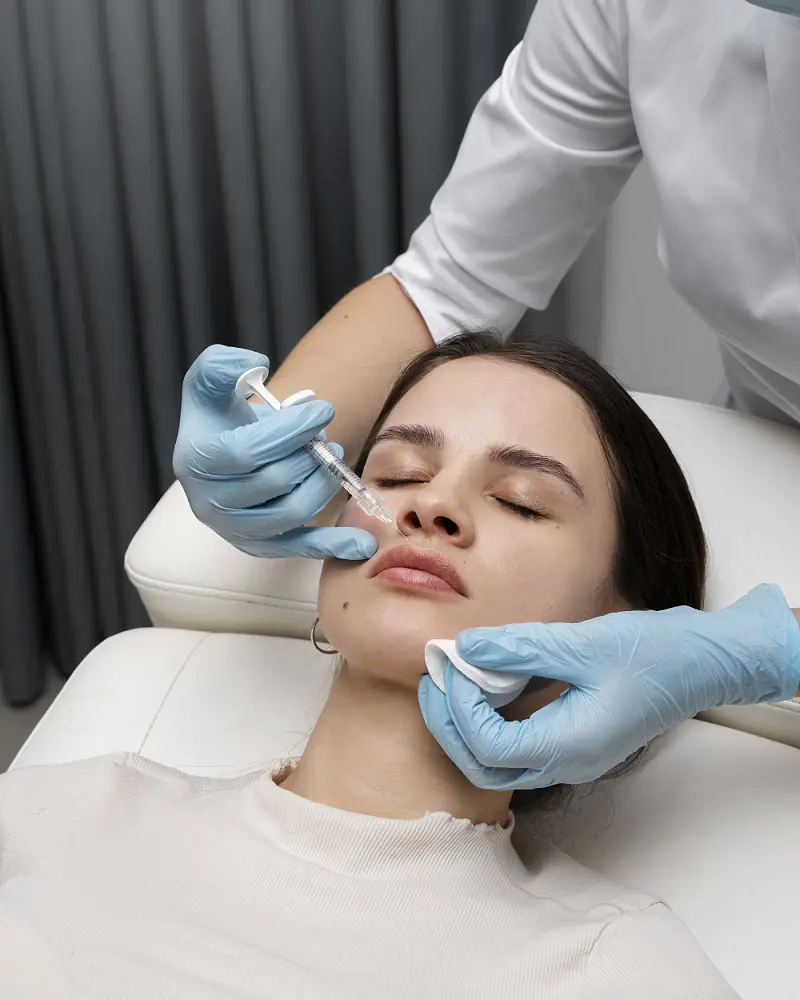The injectables, Juvederm and Botox are both effective facial treatments done to get rid of wrinkles for younger-looking skin. However, these treatments have several key differences to consider. They are noninvasive injectables that are given by a certified doctor, dermatologist, or a medical aesthetician.
While both treatments share similar goals, they contain different active ingredients. They also vary in terms of cost, timeline, and result. Moreover, there are also some risk factors that need to be considered before deciding to do these treatments.
What Is Botox?
Botox is classified as a neuromodulator because it reduces dynamic wrinkles by blocking the nerve signal to the muscles. Its FDA approval is mostly for treating areas like the forehead, glabella, and crow's feet, but it's also commonly used off-label for other facial areas such as bunny lines, frown lines around the mouth, muscles causing gummy smiles, wide chewing muscles, and vertical neck bands.
During a Botox treatment, a fine needle is used to inject the formula into the targeted muscle. Pain levels can vary, but generally, it feels like a quick pinch due to the minuscule size of the needle. The length of effects normally lasts between three and five months, depending on the patient's metabolism. And the result of the treatment becomes visible in three to five days.
What Is Juvederm?
Juvederm is a dermal filler that is made of hyaluronic acid (HA), a naturally occurring moisture molecule in the body. There are five types of Juvederm fillers available, each with specific properties based on the bonding between the HA molecules.
Juvederm and other HA fillers are safe for the body because of their natural composition. These fillers are made in high concentrations as a gel in pre-filled syringes for injection during treatments.
The different types of Juvederm fillers and their respective functions are as follows:
- Juvederm Ultra Plus: Fills areas to reduce wrinkles.
- Juvederm Voluma: Lifts sagging skin and adds volume.
- Juvederm Vollure: Smooths out facial lines and wrinkles.
- Juvederm Volbella: Hydrates and enhances the lips.
- Juvederm Volux XC: FDA-approved for defining the jawline.
Difference Between Botox vs Juvederm
Botox and Juvederm are both popular cosmetic treatments, but they serve different purposes and work in different ways. Here are brief differences between Botox and Juvederm treatment:
1. Composition and Function
Botox is a neuromodulator made from botulinum toxin type A. It works by temporarily paralyzing or weakening particular facial muscles to reduce the appearance of wrinkles caused by repetitive muscle movements. Botox is most commonly used to treat wrinkles in the forehead, glabella (between the eyebrows), and crow's feet around the eyes.
Juvederm, on the other hand, is a hyaluronic acid (HA) dermal filler. Hyaluronic acid is naturally produced in the body that helps maintain skin hydration and volume. Juvederm fillers are used to add volume, smooth wrinkles, enhance lips, and contour facial features by injecting the gel-like material into targeted areas.
2. Targeted Areas
Botox is primarily used for dynamic wrinkles in the upper face, including forehead lines, frown lines, and crow's feet. Juvederm can be used in various areas of the face, including cheeks, lips, nasolabial folds (smile lines), marionette lines, and jawline.
3. Duration of Effects
Botox results mostly last around 3 to 5 months, after which the effects gradually go off as the muscle activity returns. The longevity of Juvederm fillers varies depending on the specific product used and the area treated, but results often last from 6 months to 2 years.
4. Application Technique
Botox is performed through injections, by using microneedles directly into the target facial muscles to get the ultimate result. However, Juvederm is injected into the skin or underlying tissues in order to fill, shape, or smoothen the wrinkles.
5. Purpose
As discussed earlier, the main goal of Botox treatment is to reduce the visibility of wrinkles, giving a more relaxed and youthful appearance. Juvederm is used for adding volume, enhancing features, and achieving a smoother, younger-looking face by filling in wrinkles and restoring lost volume from the face.
Potential Side Effects of Botox
Even though Botox is generally considered safe when done by medical professionals, there are various side effects, similar to any other medical procedure. No matter how good the treatment is, there is always a chance of negative effects on certain individuals with some health issues.
So, before you begin your treatment, you and your healthcare provider must discuss the potential risks that may appear after the procedure. Here are some potential side effects:
- Some patients may experience moderate pain during or after the treatment such as nausea, or discomfort. This pain is usually temporary and goes away quickly.
- Side effects of this treatment can include swelling and bruises at the treatment site. They normally disappear in a few days, but in certain individuals, this may look more visible.
- Following the procedure, the treatment site may turn red, irritated, or itchy for a short period.
- Your dermatologist may cause temporary drooping of the brows or eyelids if they inject too much Botox above the eyebrows or too close to the upper eyelid. This mostly happens when the neurotoxic damages the muscles in nearby areas that lift these parts.
- Since Botox works by temporarily numbing the targeted facial muscles, some people may experience temporary weakness or fatigue in those areas after doing the procedures.
- The brows may peak or take on a Spock-like appearance if there is insufficient Botox injection above the lateral eyebrow. This results in an asymmetry in the relaxation of the muscles, which gives them an unnatural appearance.
Potential Side Effects of Juvederm
Just like Botox, Juvederm is also equally safe when administered by a licensed healthcare provider. However, there are minimal negative reactions linked with this injectable if you have any allergies or if your dermatologist is inexperienced.
- Bruising and swelling are some of the common side effects of this method, even when you perform this treatment by experienced professionals.
- There is a risk of unintentional vascular injections, where the filler is injected close to a blood vessel. This may be risky for the patients as it blocks blood flow to the skin. Experts recommend immediate treatment if this problem occurs.
- When too much filler is inserted in your face, the treated region may overfilled, giving it an unnatural look. This risk can be lowered by choosing a professional and licensed health provider.
- The skin at the injection site may occasionally spread tiny veins or blisters. The reason may be poor injection technique, product positioning, or the body's response to the filler. Therefore, choosing a skilled injector is essential when thinking about Juvederm.
Which Is Better: Botox or Juvederm?
The choice between Botox and Juvederm depends on a number of factors, such as particular cosmetic problems, and most importantly your doctor's recommendation. Both these treatments are done for different reasons, so one may be better suited for your needs than the other treatment.
Botox is perfect for lessening the appearance of early wrinkles caused by muscle movements. Whereas, Juvederm is used to add volume, contour facial features, and fill in static wrinkles, including nasolabial folds, marionette lines, and lips.
Botox treatment results last around 3 to 5 months in general. On the other hand, Juvederm results can last anywhere from 6 months to 2 years, depending on the specific product.
Cost Factor
As Juvederm treatments have longer-lasting effects and a unique formula, they are usually more expensive. According to the location and clinic, Juvederm injections can cost anywhere from $500 to $1,500 for each injection.
Botox treatments are usually charged per unit or injection, with an average session costing around $300. The total cost depends on the number of units required for the desired results.
Final Thoughts
In conclusion, Botox and Juvederm facial treatments offer effective solutions for addressing different cosmetic needs. Even though it's important to understand the differences between the treatments, you should visit a trained aesthetician, dermatologist, or plastic surgeon before deciding which treatment can be ideal for you.
By speaking with an expert, you clarify your objectives, get personalized guidance, and design a treatment plan that suits your requirements and expected results. In the end, your provider's expertise and guidance will ensure a safe and effective treatment experience, leading to beautiful and natural-looking results.
Content Source









